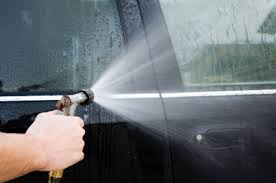Water Leaks
You might notice that you have a water leak into the passenger compartment or cargo area of your vehicle when it rains or gets wet. Lucky you. Water leaks can be very difficult to track down. I’ve dismantled entire vehicle interiors in the past in an effort to find a pesky water leak. Hopefully it won’t be that way for you. Some of the most common water leaks I find are from the windshield. Often when I find a leak of this type, the windshield has been replaced at some point. Sometimes they don’t get sealed properly and you get a leak. To verify this, you might have a friend use a garden hose on the suspected area while you sit in the vehicle looking for the source of the leak. In fact, this is how you would verify and track down just about any water leak. At one shop where I worked, we had a shower head rigged up to a garden hose on a long pole. This way we could look for leaks on our own instead of needing two people for the job. A garden hose and some duct tape would accomplish the same task.
In addition to a leak at the windshield, I have seen where the area under the windshield has rusted away, causing a leak. This is REALLY hard to find, mainly because you need to remove the windshield in order to verify a leak of this type. If you find this, you’ll have to repair the body damage before reinstalling the windshield to eliminate the leak.
Vehicles with water leaks have often been in collisions. Sometimes things get missed or not repaired properly at the body shop. So if you have a water leak and recent body shop repairs, you might look closely at the work that was done, or bring it back to the place that did the work. Either way, vehicles with collision damage are always suspect.
Sunroofs or moon-roofs are also suspect. They often have drain tubes that lead down the roof pillars that are supposed to gutter the water in the sunroof tray away. Sometimes these fail or get clogged up. When this happens, you get a nice cold shower when you make a turn. It’s not refreshing at all, trust me. You often need to remove the headliner to access these drains. Consult your service manual on this before you tear into it. This can keep you out of trouble when you tear apart your vehicle’s interior. I’ve often cleaned clogged drains with a bit of compressed air once I access them.

Lastly, if you park your vehicle under a tree, you might consider parking someplace else. Leaves and debris from trees often cause of these obstructions, not to mention the issues this debris can cause to the HVAC system.
I’ve also seen occasions when a tail light fixture was the source of a leak into the cargo area. On many vehicles, a gasket under the tail light assembly is used to seal the trunk or hatch area. When these seals fail, they can cause a water leak into the cargo area. Replacing these gaskets often repairs a leak of this type, but once again, if the vehicle has been in a collision, it might never seal correctly if the body was not repaired properly.
Door and window seals should also be inspected if you’re looking for a water leak. Any damage to a weather seal can allow water to enter the passenger compartment. It’s a good idea to inspect these seals if you have a water leak into the passenger compartment.
I’m not proud of it, but on some of my own vehicles with water leaks, I’ve drilled holes in the floor pan to give the water someplace to go. Like I said, I’m not proud of it, but it worked. If you run into a water leak that you can’t fix or are not willing to fix, this might be your option. Just a couple of small holes should do it. Just be sure you’re not drilling into anything important before you commit.
Video Title: Water Leaks- Finding and Fixing Fluid Leaks -EricTheCarGuy. Video Description: You might notice that you have a water leak into the passenger compartment or cargo area of your vehicle when it rains or gets wet. Lucky you. Water leaks can be very difficult to track down.Thumbnail: http://www.ericthecarguy.com/images/faq_buttons/leaks/Finding_and_Fixing_Fluid_Leaks_850.png
 Our Address
Our Address



